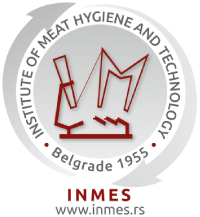Effects of different hydrocolloids on the texture profile of chicken meat emulsions
Abstract
The aim of the study was to produce chicken breast meat emulsions with the addition of different hydrocolloids that would have comparable, or better, textural properties to those produced with phosphates (E 450-452). We prepared 10 emulsions from mechanically separated chicken breast meat (as three experimental repetitions) with the additions of: phosphates (control; 0.7%), and three different levels of carrageenan and xanthan (0.5%, 0.8%, 1%), and of potato starch (1%, 1.5%, 2%). Instrumental measurements of colour (CIE L*, a*, b*) and texture (texture profile analysis, stress relaxation tests) were performed, along with evaluation of the sensory attributes (descriptive analysis). These chicken breast meat emulsions with different hydrocolloids significantly differed in their instrumentally measured colour values and most texture parameters (hardness, cohesiveness, gumminess, chewiness, resilience, F0, Y30), and in some of the sensory attributes (colour, firmness, aroma). The increases in carrageenan and potato starch additions affected some of the measured colour values and the sensory attributes, although the measured texture parameters were not affected. The increases in xanthan addition showed changes for the colour, texture and sensory profiles. These chicken breast meat emulsions with phosphate (0.7%), carrageenan (0.5%, 0.8%) and potato starch (2.0%) were most similar in colour, texture and aroma. Those with potato starch showed non-significant trends for improved attributes compared to the control group, due to their intense aroma.





